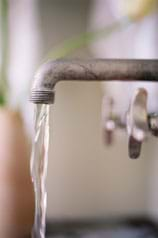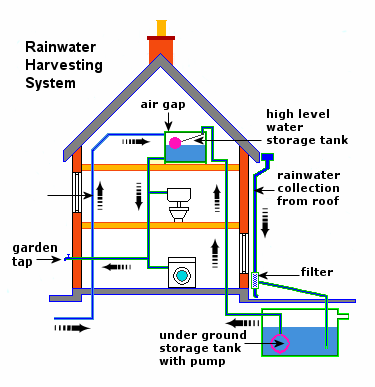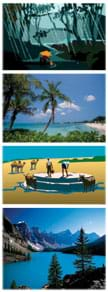Quick Look
Grade Level: 4 (3-5)
Time Required: 45 minutes
Expendable Cost/Group: US $0.00
Group Size: 2
Activity Dependency: None
Subject Areas: Earth and Space, Measurement
NGSS Performance Expectations:

| 3-5-ETS1-2 |
| 5-ESS3-1 |

Summary
In this scenario-based activity, students design ways to either clean a water source or find a new water source, depending on given hypothetical family scenarios. They act as engineers to draw and write about what they could do to provide water to a community facing a water crisis. They also learn the basic steps of the engineering design process.Engineering Connection
Water sources are increasingly becoming polluted by human-made and natural contaminants. In addition, water sources are beginning to retain less and less water for people's' daily needs. Engineers have long recognized this as a growing problem, and they are being called upon to design better ways to manage our water resources and develop advanced technologies to clean our water and to preserve and protect our water sources. Finding solutions to meet a community's water needs requires that engineers take into consideration the region's climate as well as the available natural and human resources.
Learning Objectives
After this activity, students should be able to:
- List several real scenarios that involve threats to community water resources.
- Explain the importance and challenges involved in cleaning water for human use.
- Describe how engineers are involved with finding and cleaning water.
Educational Standards
Each TeachEngineering lesson or activity is correlated to one or more K-12 science,
technology, engineering or math (STEM) educational standards.
All 100,000+ K-12 STEM standards covered in TeachEngineering are collected, maintained and packaged by the Achievement Standards Network (ASN),
a project of D2L (www.achievementstandards.org).
In the ASN, standards are hierarchically structured: first by source; e.g., by state; within source by type; e.g., science or mathematics;
within type by subtype, then by grade, etc.
Each TeachEngineering lesson or activity is correlated to one or more K-12 science, technology, engineering or math (STEM) educational standards.
All 100,000+ K-12 STEM standards covered in TeachEngineering are collected, maintained and packaged by the Achievement Standards Network (ASN), a project of D2L (www.achievementstandards.org).
In the ASN, standards are hierarchically structured: first by source; e.g., by state; within source by type; e.g., science or mathematics; within type by subtype, then by grade, etc.
NGSS: Next Generation Science Standards - Science
| NGSS Performance Expectation | ||
|---|---|---|
|
3-5-ETS1-2. Generate and compare multiple possible solutions to a problem based on how well each is likely to meet the criteria and constraints of the problem. (Grades 3 - 5) Do you agree with this alignment? |
||
| Click to view other curriculum aligned to this Performance Expectation | ||
| This activity focuses on the following Three Dimensional Learning aspects of NGSS: | ||
| Science & Engineering Practices | Disciplinary Core Ideas | Crosscutting Concepts |
| Generate and compare multiple solutions to a problem based on how well they meet the criteria and constraints of the design problem. Alignment agreement: | Research on a problem should be carried out before beginning to design a solution. Testing a solution involves investigating how well it performs under a range of likely conditions. Alignment agreement: At whatever stage, communicating with peers about proposed solutions is an important part of the design process, and shared ideas can lead to improved designs.Alignment agreement: | Engineers improve existing technologies or develop new ones to increase their benefits, to decrease known risks, and to meet societal demands. Alignment agreement: |
| NGSS Performance Expectation | ||
|---|---|---|
|
5-ESS3-1. Obtain and combine information about ways individual communities use science ideas to protect the Earth's resources and environment. (Grade 5) Do you agree with this alignment? |
||
| Click to view other curriculum aligned to this Performance Expectation | ||
| This activity focuses on the following Three Dimensional Learning aspects of NGSS: | ||
| Science & Engineering Practices | Disciplinary Core Ideas | Crosscutting Concepts |
| Obtain and combine information from books and/or other reliable media to explain phenomena or solutions to a design problem. Alignment agreement: | Human activities in agriculture, industry, and everyday life have had major effects on the land, vegetation, streams, ocean, air, and even outer space. But individuals and communities are doing things to help protect Earth's resources and environments. Alignment agreement: | A system can be described in terms of its components and their interactions. Alignment agreement: Science findings are limited to questions that can be answered with empirical evidence.Alignment agreement: |
International Technology and Engineering Educators Association - Technology
-
Students will develop an understanding of the attributes of design.
(Grades
K -
12)
More Details
Do you agree with this alignment?
-
Students will develop an understanding of engineering design.
(Grades
K -
12)
More Details
Do you agree with this alignment?
-
Identify and collect information about everyday problems that can be solved by technology, and generate ideas and requirements for solving a problem.
(Grades
3 -
5)
More Details
Do you agree with this alignment?
State Standards
Colorado - Science
-
Create and evaluate models of the flow of nonliving components or resources through an ecosystem
(Grade
4)
More Details
Do you agree with this alignment?
-
There is interaction and interdependence between and among living and nonliving components of ecosystems
(Grade
4)
More Details
Do you agree with this alignment?
Materials List
Each group needs:
- one large sheet of paper, poster board or chart paper
- colored pencils or markers
- one water problem scenario from the Family Scenario Note Cards
Worksheets and Attachments
Visit [www.teachengineering.org/activities/view/cub_earth_lesson3_activity1] to print or download.Pre-Req Knowledge
Some familiarity with the water cycle.
Introduction/Motivation
What would happen if you woke up tomorrow, turned the water tap on for a drink, and dirty brown water came out? How about if you turned the water faucet and no water came out? What would happen if, at home this evening, people came by your house and said that you should not drink your water because a terrible contaminant (pollution) had been found in it? What if people said you had to limit your water use because we were running out? What would you do? This all sounds really bad, but it actually happens!

All over the world, problems of water quality and quantity are very real. In Bangladesh, a contaminant known as arsenic was found in many water sources. Arsenic in very small amounts causes skin and internal cancers. Yikes! You don't want to drink arsenic! In other parts of the world people must walk very long distances everyday to get water because it is not piped to where they live. They do not have water faucets or wells. Sometimes their trek to get water is tiring or dangerous. In the U.S., after Hurricane Katrina, water supplies in parts of New Orleans were too dirty for drinking. The water was filled with dirt and sand. You don't want to drink water filled with dirt, do you? Also, regions in the southwestern U.S. have been having a water shortage for years. There just is not enough water for everyone who needs it.
Hundreds of years ago, these problems existed too. What ideas do you think people had a long time ago to fix these sorts of problems? Well, ancient Jordanians developed a highly extensive system of cisterns (underground water tanks) and pipes to collect and distribute water. In Cambodia and other places, people developed ways to naturally clean water on the bottom of riverbeds. Some of these ancient technologies still exist today. Many places in Europe, including Germany, still partly clean water by filtering it through river banks.
How about getting water in the first place? What type of climate do you live in? Do you know the source of your drinking water? Often, people collect precipitation. In Asia and Africa, communities collected rainwater as a source of fresh water. Rainwater is still collected today to use for drinking and daily water use (see Figure 1).
What do we do when these water problems occur? Environmental engineers, water resource engineers, chemical engineers and many other people work on ways to solve these problems. Engineering teams and companies often develop new technologies to clean up dirty or polluted water, and collect and conserve our water sources. Today we are going to act as engineering companies, looking at different situations in which water sources are threatened. We will even design ways to handle specific water problems. Are you ready?
Procedure
Background Information: Engineering Design Process
Engineers design and build all types of structures, systems and products that are important in our everyday lives. The engineering design process is a series of steps that engineering teams use to guide them as they solve problems:
- Ask to identify the need: What is the problem? What do I want to do? What are the project requirements? What are the limitations? Who is the customer? What is the goal? Gather information and research what others have done.
- Research: Research the problem.
- Brainstorm and design: Imagine and brainstorm ideas. Be creative. Explore, compare and analyze many possible solutions. Select the most promising idea.
- Plan: Draw a diagram of your idea. How will it work? What materials and tools are needed? How will you test it to make sure it works?
- Create: Assign team tasks. Build a prototype (model). Does it work? Talk about what works, what doesn't and what could work better.
- Test: Test and evaluate the protoype.
- Improve: Talk about how you could improve your product. Make revisions. Draw new designs. Make your product the best it can be.
Engineers use their science and math knowledge to explore options and compare many ideas. This is called open-ended design because when you start to solve a problem, you don't know what the best solution will be. The process is cyclical and may begin at, and return to, any step.
The use of prototypes (model), or early versions of the design helps the design process by improving the understanding of the problem, identifying missing requirements, evaluating design objectives and product features, and getting feedback from others.
Engineers select the solution that best uses the available resources and best meets the project's requirements. They consider many factors: Cost to make and use, quality, reliability, safety, functionality, ease of use, aesthetics, ethics, social impact, maintainability, manufacturability.
Before the Activity
- Gather materials.
- Make copies of the Family Scenario Note Cards (contains five different scenarios) and cut out the water problem scenarios.
With the Students: Design
- Divide the class into teams of two or three students each. Tell the students that each team represents a water engineering company that helps solve the problems of families or communities that need clean drinking water.

- Conduct the pre-activity assessment activity described in the Assessment section.
- Write the steps of the engineering design process on the board. Review with students how all engineers like to solve problems to make things better. These are the usual steps they take when working on a problem, just like what they are doing today.
- Hand each team a water problem scenario.
- Allow each team time to brainstorm a way to fix the problem. Let them know that any design or method is fine, except they must be realistic for their situation. Consider the resources and limitations of the climate of their scenario. Encourage them to be creative! As needed, guide and evaluate them with questions provided in the Assessment section. Have teams draw their engineering method(s) to fix their water problem scenarios on large paper using markers or colored pencils. Ask students to label the parts of their designs and be as detailed as possible. Point out how designing, planning and creating a model are steps in the engineering design process.
- Have students decide on a name for their engineering company and write it on the top of their design drawing.
With the Students: Presentation
- Have each engineering team present its design to the class, and explain how it will solve the family's water problem.
- Conclude by leading a class discussion. Why do we need clean water? Is finding water different in different climates? What are the types of real-world situations that can threaten our community water resources? What are the problems we might have in trying to clean dirty water so it is okay for human use? How do engineers help us? (Possible answers: Water collection, water treatment.) What are the steps of the engineering design process? Any time you are solving a problem or building something, think about the engineering design process. It helps you think through all aspects of a problem to find a good solution. When you saw other team presentations, did you get any ideas that would improve your design?
- Conduct the post-activity assessment activity described in the Assessment section.
Vocabulary/Definitions
brainstorming: A method of shared problem solving in which all members of a group contribute many ideas.
cistern: A receptacle for holding water or other liquid, especially a tank for catching and storing rainwater.
climate: The meteorological conditions (weather), including temperature, precipitation and wind that characteristically prevail in a particular region. A region of the earth having particular meteorological conditions, for example: desert, coastal, mountainous or alpine, river valley and tropical climates.
conserve: To use carefully or sparingly, avoiding waste.
contaminant: A substance that makes something impure or unclean by contact or mixture.
design: To create for a particular purpose or effect. For example: Design a water collection system.
engineering design process: A decision-making process used by engineers to make something that meets a need or solves a problem.
model: A small object that represents in detail another, often larger object.
pollution: The contamination of soil, water or the atmosphere by contaminants.
precipitation: Any form of water (rain, snow, sleet or hail) that falls to the earth's surface.
tap: A valve and spout used to regulate delivery of a fluid at the end of a pipe.
water cycle: How water circulates through the atmosphere. The cycle of evaporation and condensation that controls the distribution of the earth's water as it evaporates from bodies of water, condenses, precipitates and returns to those bodies of water.
water quality: Water characteristics that determine its suitability for various uses.
well: A deep hole or shaft sunk into the earth to obtain water, oil, gas or brine. A container or reservoir for a liquid. A place where water issues from the earth (a spring).
Assessment
Pre-Activity Assessment
On Your Toes Brainstorming: In small groups, have students engage in open discussion. Remind students that no idea or suggestion is "silly." All ideas should be respectfully heard.
- Assign each team a particular climate (tropical, coastal, alpine, desert, etc.). For two minutes ask them to brainstorm and write down different water sources for their particular climate.
- Disaster strikes! After two minutes, go around to each group and tell them that they could no longer get water from the major water source they listed! Ask them to brainstorm what they could do if this water source was removed.
Activity Embedded Assessment
Group Questions: During the activity, visit each group and ask the following questions:
- How does this design relate to the climate in which your family or community lives?
- Why did you choose this design?
- What sort of power or energy needs would your design need? (For example, if the design involves moving or pumping the water, do they need a pump? What will power the pump? Batteries or electricity, etc.)
Post-Activity Assessment
Re-Engineering: Have each team switch their original family scenario note card with another group. Ask students to evaluate their current design for this new scenario. Have students discuss if and why their design would or would not work in this different situation in a different climate. Ask them to think about what they could do to make it work for the new conditions.
Troubleshooting Tips
When coming up with design solutions, make sure students use realistic approaches and think about the climate conditions. Some teams made need a little encouragement to find a solution.
Activity Extensions
Have other student engineering teams in the class evaluate and offer suggestions for improvements to each design.
Have the students make physical models of their solutions to the water problems.
Have students present their designs to another class.
Subscribe
Get the inside scoop on all things TeachEngineering such as new site features, curriculum updates, video releases, and more by signing up for our newsletter!References
Dictionary.com. Lexico Publishing Group, LLC. Accessed March 22, 2006.
Rain Water Harvesting. Updated January 18, 2006. Directorate of Special Village Panchayats, Chennai, India. Originally found at http://www.tn.gov/ Accessed March 22, 2006. (Source of Figure 1)
Copyright
© 2006 by Regents of the University of Colorado.Contributors
Jay Shah; Malinda Schaefer Zarske; Denise W. CarlsonSupporting Program
Integrated Teaching and Learning Program, College of Engineering, University of Colorado BoulderAcknowledgements
The contents of these digital library curricula were developed by the Integrated Teaching and Learning Program under National Science Foundation GK-12 grant no. 0338326. However, these contents do not necessarily represent the policies of the National Science Foundation, and you should not assume endorsement by the federal government.
Last modified: September 22, 2020






User Comments & Tips